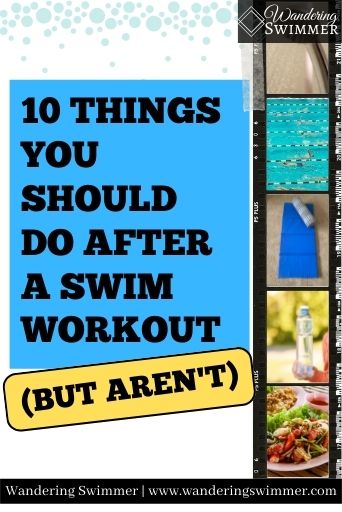Written By: Chevron
It’s easy to focus on what you should be doing during a swim workout. But what should you be doing after a swim workout? While these aren’t hard and true rules that you should follow (except for number one), they can make things easier for you. Both physically and mentally.
Here are 10 things you should do after a swim workout. But probably aren’t 😉
More Content for You: Swimming Basics to Get You Started
Disclosure: This post may contain affiliate links, meaning we earn a small commission at no cost to you if you purchase something through one of our links. As an Amazon Associate, we earn from qualifying purchases. Please check out our disclosure page for more information.

Taking Care of Yourself After a Swim Workout
Part of exercising is taking care of your health. It’s easy to focus on just the workout itself. But taking care of yourself after your swimming workout (or any workout!) is just as important. Doing so after each workout can help your body recover and mentally get you into a better place.
1. Eat
Swimming burns hundreds of calories in a short amount of time. And after any workout, you should eat something so your body can replenish what it lost. Eating directly after swimming can help your muscles recover faster and build new muscle tissue.
Ideally, you should have a small, healthy snack right after your workout. And when you get home or to work, eat something larger. To make the most of your workout, try your best to eat as soon as you finish your workout. Preferably within 20-30 minutes of cooling down. Whether that’s a smoothie, protein shake, or a meal.
More Content for You: Basic Pool Etiquette: 15 Ways to Share the Pool
2. Rinse-Off/Shower
Taking even five minutes to rinse off can help you take care of yourself after a swim workout. Showering helps remove the chlorine, salt water, or other pool chemicals from your skin and hair. Even if you wore a swim cap, your hair isn’t completely protected.
Related articles:
While showering with body wash and shampoo/conditioner is ideal, we understand that not everyone has the time for it. If that’s the case, even just a quick rinse can help. Not only will this help clean your hair and body, but it can also help you unwind from your workout. Especially if you’re not happy with how your workout went.
Related article: The 7 Best Swim Shampoos to Remove Chlorine
3. Stretch
While you should stretch before getting into the water, you should also stretch after your swim workout. Doing this can help prevent injury by reducing any lactic acid that built up in your muscles. And it can also be used to increase your flexibility, as your muscles and joints are already warm.
Stretching after a swim workout is especially important if you skipped a cool down. Or, if you didn’t have enough time to do a longer, more thorough cool down. Do some rotations and other dynamic stretches to get the most out of your stretching session. And to keep cooling down your muscles. You can also use stretch bands to add to your stretching.
Dynamic stretches are exercises such as:
- Arm circles
- Lunges and squats
- Trunk/torso twists
- Jumping jacks
- Leg swings
Or, try static stretches to improve your flexibility.
Some static stretches are:
- Hamstring and calf stretches
- Shoulder stretch
- Overhead tricep stretch
4. Drink Water
Hydration is key whether you’re working out or not. It’s important to stay hydrated during and after your workout. Keeping your body well hydrated can help with muscle recovery. And for some, staying hydrated can also reduce the soreness that comes with working out.
Related article: 7 Common Swimming Myths
If it’s hard to drink water, try flavored water or packets of flavor to make it easier to drink. Just watch the sugar and salt so you’re not getting these in excess.
Drinking water is best for staying hydrated, as drinks such as soda, coffee, or alcohol can make you dehydrated. And when you’re dehydrated, you can’t perform at your best level.
Taking Care of Your Gear/Equipment
Much like taking care of yourself is important, so too, is taking care of your gear and equipment. Your gear performs best when it’s not falling apart or broken. And the best way to prevent this is to take care of it.
5. Rinse Out Your Suit
The simple act of rinsing your swimsuit out with fresh water after a swim workout can help extend the life of your swimsuit. Chlorine especially eats away at the fabric and elastic over time. And saltwater can be just as rough on fabric. Rinsing out your swimsuit can help remove the chemicals from the fabric.
More Content for You: How Many Laps in a Pool is a Mile?
Take a minute or so to thoroughly run your suit under some water. Or soak it in a sink or bucket for a few minutes. Once done, squeeze, but don’t wring, out the excess water. And lay it out flat to dry.
6. Dry Your Cap and Goggles
It takes about 30 seconds or so to dry off the outside and inside material of your swim cap before putting it away. Doing so can also keep items in your swim bag dry and prevents mold from growing in your swim cap.
While you’re drying off your cap, take another few seconds to wipe off water on your goggles. Dry off only the straps and outside lens of the goggle. Drying off the inside of the lens can remove the antifog coating.
Related articles:
- 8 Reasons Your Swim Cap Slides Off
- 7 Reasons to Wear Goggles When You Swim
- 6 Best Prescription Goggles for Swimming
7. Let Your Gear Dry
Leaving your gear to sit around in a wet gear bag can shorten the life of some of the material. Rubber fins and the straps on paddles, for example. It can also make the inside of your car or trunk start to smell like chlorine.
If you can, hang up your gear bag so the water can drip off everything and start to dry. Storing your gear in a locker is okay, just make sure you let it vent so it doesn’t start to mold or smell.
More Content for You: 6 Best Mesh Gear Bags for Swimming
Don’t have a gear bag? Take your gear out of your car if you store it there and bring it inside so it can dry. This has the extra benefit of keeping it away from the heat or cold, where the temperatures can also ruin the material.
You should also pull any gear out of your bag if you keep it there. Or dry them off before tossing them in your bag.
8. Empty/Clean Out Your Swim Bag
Do yourself (and your belongings) a favor and pull out all wet/damp items in your swim bag after every swim workout. And make sure you dry all your wet items thoroughly to prevent the build-up of mold.
The quickest way to make your swim bag start to smell is by leaving wet towels, suits, or clothes in them. It’s also the best way to ruin your towels and swimsuits. Mold grows quicker on your towels than you realize if you’re not thoroughly drying them each day. And washing them weekly.
Related articles:
- 8 Best Swim Bags for Swimmers (And Water Enthusiasts)
- A Swimmer’s Review of Arena’s Team 45 Swim Bag
9. Thank Your Coach (if You Have One)
If you have a coach, take a few seconds to thank them at the end of your swim workout.
Coaches put time and effort into writing each workout. Along with being at the pool to critique and offer suggestions during your training session. For some, it’s a lot of hours. And they’re typically hours that most people don’t recognize. Despite all the work that went into it.
Related article: 8 Awesome Gift Ideas for Swim Coaches
Try to get into the habit of telling your coach thanks, preferably after every workout, if you can. It doesn’t cost you anything, takes no more than 15 seconds, and you can easily make someone’s day for it. 🙂

10. Words of Encouragement or Praise
At the same time, take a few moments to tell your teammates or workout partners ‘good job’. Recognize their accomplishments for that workout with some praise or other uplifting words. This goes a long way for some swimmers. More so than you would think.
Even a high five or a fist bump, followed by a ‘great workout’, can make someone feel better about their workout. You don’t need to gush about all that they did. Simple is best.
Again, it doesn’t take much of your time or effort. And you’ll be surprised at how many people start to follow your lead and do the same. Don’t be afraid to start a new and positive trend at your pool!
In Closing
It might seem like a long to-do checklist after you finish a swim workout. But most of these tasks take very little time. And they’ll go a long way for your physical and mental health in doing so. Along with keeping your gear and equipment lasting long.
As always, happy swimming!
– Chevron
Bonus Content
Basic Swimming Terminology: Swimming has a plethora of swim jargon that sounds almost like another language. Here are 25 quick, but important swimming terms to help you find success in swimming!
How to Do a Workout in a Small Backyard Pool

Want to Improve at the Pool?
Join swimmers and swim parents to receive my free newsletter and receive a free Swimming Glossary e-book as a thanks!
Every month you’ll receive tips and coaching to help you find success at the pool.
About

Chevron is a current competitive swimmer with almost 20 years of experience at the local, national and international level. A current USA Swimming and US Masters Swimming athlete, she’s committed to providing guidance to all levels of swimmers and believes that everyone should know how to swim.
